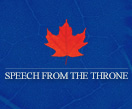

Frequently Asked Questions (FAQs)
Q1: What is the Speech from the Throne?
A1: The Speech from the Throne officially opens every new session of Parliament. The Speech sets out the broad goals and directions of the government and its strategy to accomplish those goals. The Speech is given by Canada's Head of State, the Queen, or, more usually, by her representative, the Governor General. It is called the Speech from the Throne because the Governor General reads it while sitting in the seat in the Senate Chamber reserved for the Head of State or her representative, as the head of Canada’s system of executive government. The Governor General reads the speech to a gathering of Parliamentarians (Members of the House of Commons and Senators) and others. Parliamentarians act as law-makers for bills, or proposed laws, brought to Parliament for debate and decision.
Q2: When is the Speech given?
A2: Each Parliament begins with a Speech from the Throne and, until the speech is delivered, no public business may be conducted by either the Senate or the House of Commons. The Speech officially opens every new session of Parliament.
Q3: Why does the Governor General give the Speech?
A3: Parliament consists of the Queen and members of the Senate and the House of Commons. Parliament meets only at the "Royal summons" of the Queen, represented federally by the Governor General. The Senate and House of Commons cannot open a session by their own authority, and a number of formalities must accompany the opening of Parliament.
Q4: Why is the Speech given in the Senate?
A4: The Canadian Parliament was modelled on that of the United Kingdom. Both have an upper Chamber whose members are appointed, and a lower Chamber, the House of Commons, whose members are elected by the general population. In Canada, Senators are appointed by the Governor General on the recommendation of the Prime Minister. Since neither the Governor General nor Senators are allowed to enter the House of Commons, the Speech is given in the Senate Chamber.
Q5: The "Usher of the Black Rod" summons the Members of the House of Commons to hear the Speech from the Throne. What is the origin of this office and practice?
A5: The Usher of the Black Rod is appointed by the Governor in Council (the Governor General upon the advice of Cabinet), and has a number of ceremonial and security-related duties. The office dates back to 14th century England. The title was changed from "Gentleman Usher of the Black Rod" in 1997, when the first woman was appointed to the position.
Q6: What is Canada's political system called?
A6: Canada's political system is modelled on that of the United Kingdom and is a Parliamentary democracy with a system of responsible government."Democracy" means government by the people.
In a system of responsible government, the executive (Cabinet) initiates policy and alone has authority to introduce legislation for the raising of revenue and the expenditure of moneys. It must maintain the confidence of the representative body (Parliament), which passes the laws and exercises a function of scrutiny and supervision. To do this effectively, the Prime Minister and other members of Cabinet have seats in the Parliament and are accountable to the House of Commons. If they cannot maintain the confidence or support of the majority of the members of the House, they must resign, or ask the Governor General to dissolve Parliament and to call an election.
Q7: Who writes the Speech from the Throne?
A7: The government of the day writes the speech. The Governor General is invited to contribute introductory material dealing with his or her own activities and with royal visits.
Q8: What does the Speech say?
A8: Speech from the Throne 2006
Q9: Are previous Speeches from the Throne available?
A9: Previous Speeches from the Throne. Since the Speech from the Throne is also incorporated into the Official Report of Debates (Hansard), previous Speeches can be found through this House of Commons publication.
Q10: What is the role of the Governor General in the Speech from the Throne?
A10: In Canada's system of responsible government, the Crown represented by the Governor General acts on the advice of Ministers. The Speech from the Throne sets out the government's broad goals and directions and proposed legislative program.
Q11: What happens after the Speech from the Throne is read?
A11: Standing Orders, the rules of the House of Commons, require six days of additional debate after the speech is given:
Day of the Speech: The Speech is given. Following the speech, two MPs selected by the Prime Minister move and second respectively an Address in Reply to the Speech from the Throne which offers the thanks of the House of Commons for the Governor General's speech.
Day 1: The debate on the Address in Reply continues on the day following the Speech. It is the first of the six additional days.
The Leader of the Opposition makes a speech regarding the government's intentions and moves an amendment to the Address in Reply. The Prime Minister makes a speech elaborating on certain aspects of the Speech from the Throne. The Speech from the Throne and the Prime Minister's speech, therefore, provide the foundation for the government's legislative priorities and agenda for the current session of Parliament. The other opposition parties then enter the debate.
Day 2-6: Debate continues and closes with votes at end of second, fourth and sixth days of debate, to determine the House's confidence in the government and the program set out in the Speech.
Updated: 2006-04-04
Français | Contact Us |
Help | Search | Canada Site
Complete Speech | FAQs | Highlights |
PDF Versions | PM's
Web site